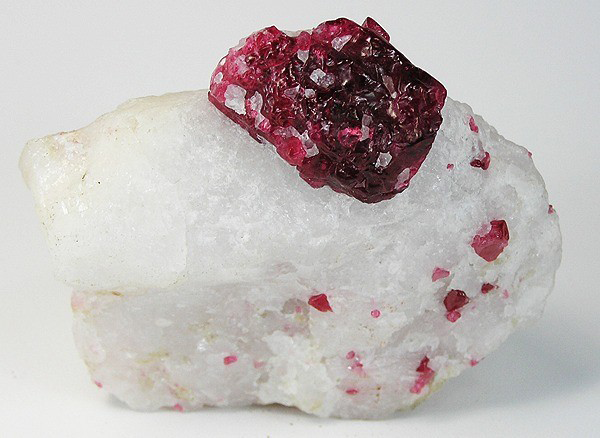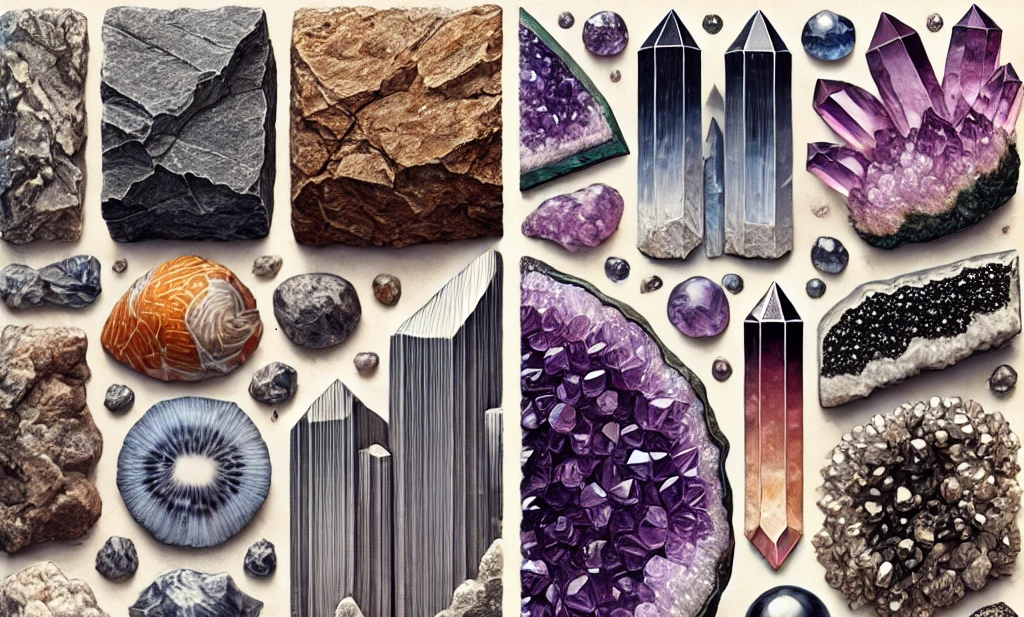What is the Difference Between Rocks and Minerals?
Differences Between Rocks and minerals are two fundamental components of Earth’s structure, yet they differ in significant ways. The main difference is that minerals are naturally occurring substances with a definite chemical composition and crystalline structure, while rocks are aggregates of one or more minerals. Understanding the distinction between rocks and minerals is essential for geology and Earth science, as it helps explain the processes that shape our planet.
In everyday conversations, the terms “rock” and “mineral” are often used interchangeably. However, for anyone exploring geology, these differences become crucial. Minerals are specific chemical compounds, whereas rocks are more complex, and made of different mineral combinations. Let’s delve deeper into what sets them apart and how they form.
What Are Minerals?
Minerals are naturally occurring, inorganic substances with a definite chemical composition and an ordered atomic structure. These substances are the building blocks of rocks, forming under specific conditions in Earth’s crust through various geological processes. What sets minerals apart is their unique combination of chemical makeup and crystalline structure, which gives each mineral its distinct physical properties such as hardness, color, luster, and crystal form.

Key Characteristics of Minerals
Naturally Occurring: Minerals are formed by natural processes, such as cooling magma or crystallization from water, without human intervention.
Inorganic: Unlike living organisms, minerals are inorganic, meaning they are not made from plant or animal material.
Definite Chemical Composition: Each mineral has a specific chemical formula, which can range from simple to complex. For example, quartz is composed of silicon dioxide (SiO₂), while calcite is calcium carbonate (CaCO₃).
Ordered Atomic Structure: The atoms in a mineral are arranged in a specific, repeating pattern, forming a crystal lattice. This orderly structure gives rise to distinct geometric shapes in many minerals.
Formation of Minerals
Minerals form through various geological processes, including:
- Crystallization from magma or lava: As molten rock cools, minerals such as feldspar, mica, and quartz crystallize.
- Precipitation from water: When water evaporates, minerals like halite (rock salt) and gypsum can form as the dissolved substances become solid.
- Metamorphism: Minerals like garnet or talc can form under extreme heat and pressure conditions in the Earth’s crust.
Types of Minerals
Minerals are categorized into groups based on their chemical composition. Some of the major groups include:
- Silicates: Comprising over 90% of Earth’s crust, silicates contain silicon and oxygen. Examples include quartz, feldspar, and mica.
- Carbonates: These contain carbon and oxygen and are found in sedimentary rocks. Calcite and dolomite are well-known carbonates.
- Oxides: Minerals like hematite and magnetite, which form from the combination of oxygen with metals, are examples of oxides.
- Sulfides and Sulfates: These include minerals like pyrite (sulfide) and gypsum (sulfate), each forming under different environmental conditions.
What Are Rocks?
Rocks are naturally occurring solid aggregates composed of one or more minerals or mineraloids. Unlike minerals, which have a specific chemical composition and crystalline structure, rocks are a mixture of different minerals and other organic or inorganic materials. They form the foundation of Earth’s crust and are classified based on their formation processes into three main types: igneous, sedimentary, and metamorphic.
Key Characteristics of Rocks
- Aggregates of Minerals: Rocks are made up of various minerals combined together. For instance, granite consists of quartz, feldspar, and mica, while limestone is predominantly made of the mineral calcite.
- No Definite Chemical Composition: Unlike minerals, rocks do not have a fixed chemical formula. Their composition can vary significantly depending on the types of minerals present and the conditions under which they are formed.
- Formed by Geological Processes: Rocks are shaped by natural forces over long periods. Processes like cooling, pressure, erosion, and heat contribute to the formation of different types of rocks.
Types of Rocks
There are three primary types of rocks based on their formation processes:
- Igneous Rocks:
- Formation: These rocks form from the cooling and solidification of magma or lava. Magma cools below the surface, forming intrusive igneous rocks like granite, while lava cools on the surface to create extrusive igneous rocks like basalt.
- Examples: Granite, basalt, obsidian.
- Sedimentary Rocks:
- Formation: Sedimentary rocks form from the accumulation and compaction of sediments such as sand, mud, and organic material over time. These sediments are often transported by water, wind, or ice and eventually settle in layers, becoming cemented into solid rock.
- Examples: Limestone, sandstone, shale.
- Metamorphic Rocks:
- Formation: Metamorphic rocks are formed when existing rocks are subjected to intense heat and pressure, causing their mineral structure to change without melting. This process, called metamorphism, creates new minerals and textures in the rock.
- Examples: Marble, slate, schist.
Formation Processes of Rocks
- Igneous: Formed from the solidification of molten rock, either from magma beneath the Earth’s surface (intrusive) or lava on the surface (extrusive).
- Sedimentary: Created from the accumulation, compaction, and cementation of sediments derived from pre-existing rocks or organic material.
- Metamorphic: Result from the alteration of existing rocks under extreme heat and pressure within Earth’s crust, changing their mineral composition and structure.
Key Differences Between Rocks and Minerals
Rocks and minerals are often mentioned together in geology, but they are fundamentally different in their properties, formation, and uses. Understanding the key differences between rocks and minerals is crucial to gaining insights into the Earth’s structure and the processes that shape our planet. Let’s break down the differences in detail:
Composition
- Minerals: A mineral is a naturally occurring, inorganic substance with a definite chemical composition. Each mineral has a unique chemical formula, which can be written out like a chemical equation. For example, quartz is composed of silicon and oxygen (SiO₂), while calcite is made of calcium carbonate (CaCO₃). This specific composition gives each mineral its characteristic physical properties, such as hardness, luster, and color.
- Rocks: Rocks are aggregates of one or more minerals or mineraloids (minerals that lack a crystalline structure). Unlike minerals, rocks do not have a fixed chemical formula. A single rock can contain several different minerals. For example, granite is composed of quartz, feldspar, and mica. This combination of minerals results in a more complex structure and appearance than a single mineral.
Crystalline Structure
- Minerals: One of the defining features of a mineral is its crystalline structure. This means that the atoms in a mineral are arranged in a specific, repeating pattern, which gives the mineral its distinct shape. Each mineral’s internal structure leads to its unique crystal form, which is why minerals like quartz have a well-defined, six-sided crystal shape.
- Rocks: Rocks, being composed of various minerals, do not have a uniform crystalline structure. The minerals within a rock may have their crystalline structure, but the rock itself lacks a consistent crystal form. Instead, the texture and appearance of rocks are determined by how the minerals within them interact and bond together.
Formation Process
- Minerals: Minerals form through a variety of geological processes, including:
- Crystallization from magma or lava: As molten rock cools, minerals like olivine and quartz crystallize and grow.
- Precipitation from water: Minerals like halite (rock salt) form when water evaporates, leaving the dissolved mineral behind.
- Metamorphism: Heat and pressure can cause minerals to change into new minerals, such as the transformation of graphite into diamond.
- Rocks: Rocks form through different processes that involve the combination of minerals. The formation of rocks can be categorized into three main types:
- Igneous rocks: Form when magma or lava cools and solidifies. Example: Granite.
- Sedimentary rocks: Form from the accumulation and compaction of sediments, such as sand, mud, or organic material. Example: Sandstone.
- Metamorphic rocks: Form when existing rocks are subjected to high heat and pressure, causing changes in mineral composition. Example: Marble (which forms from limestone).
Classification
- Minerals: Minerals are classified based on their chemical composition and physical properties. There are over 4,000 known minerals, which are grouped into categories like:
- Silicates: Comprising most of Earth’s crust, includes minerals like quartz and feldspar.
- Carbonates: Includes minerals like calcite, often found in sedimentary rocks.
- Oxides: Includes minerals like hematite and magnetite, common in iron ores.
- Rocks: Rocks are classified based on how they form. As mentioned earlier, the three main categories are:
- Igneous rocks: Formed from cooling magma or lava.
- Sedimentary rocks: Formed from sediment compaction.
- Metamorphic rocks: Formed from the transformation of existing rocks under heat and pressure.
Physical Properties
- Minerals: Minerals have a set of specific physical properties that help in their identification:
- Hardness: Measured on the Mohs hardness scale, minerals can range from very soft (talc) to very hard (diamond).
- Luster: The way a mineral reflects light, whether metallic, glassy, or dull.
- Cleavage and Fracture: Minerals break along specific planes (cleavage) or in irregular patterns (fracture).
- Color: While color can vary, it is often used as a preliminary identification method for minerals.
- Rocks: Rocks do not have as specific physical properties as minerals because they are made up of different minerals. However, rocks can still be described by their:
- Texture: The size, shape, and arrangement of minerals within the rock. For example, granite has a coarse texture, while obsidian is glassy and smooth.
- Grain Size: In sedimentary rocks, the size of the grains (e.g., sand-sized or clay-sized) helps classify the rock.
- Hardness and Durability: Rock hardness can vary depending on the minerals present and their formation process.
Identification
- Minerals: Minerals can be identified using specific tests and observations:
- Hardness test: Scratching the mineral against a known reference, such as a steel blade or glass.
- Streak test: Rubbing the mineral on a porcelain plate to observe the color of its powder.
- Crystal form: Observing the geometric shape in which the mineral naturally grows.
- Rocks: Identifying rocks requires looking at the minerals present, as well as the texture and grain size. For example, identifying an igneous rock involves determining if it’s intrusive (formed inside Earth) or extrusive (formed on the surface). Identifying a sedimentary rock may involve looking for layers or fossils.
Occurrence in Nature
- Minerals: Minerals are the basic building blocks of rocks, meaning they are found within rocks themselves. Some minerals also occur in pure form, such as gold or diamonds.
- Rocks: Rocks make up the Earth’s crust and are found everywhere in nature. They can be found in various forms, from mountain ranges and ocean floors to riverbeds and deserts. Rocks are continually broken down by weathering and erosion, forming sediments that eventually turn into new sedimentary rocks.
Summary of the Key Differences
- Minerals are single, naturally occurring substances with a specific chemical composition and crystalline structure, whereas rocks are aggregates of minerals.
- Minerals have a uniform structure and composition, while rocks can be made of several minerals and may include other materials.
- Minerals are classified by their composition and properties, whereas rocks are classified by how they form (igneous, sedimentary, or metamorphic).
- Minerals can be identified by their hardness, luster, cleavage, and other properties, while rocks are identified based on the minerals they contain and their overall texture.
By understanding these key differences between rocks and minerals, we gain deeper insights into the fundamental components of Earth’s geology and how they contribute to the processes that shape the planet.
How Rocks and Minerals Interact
Rocks and minerals are interconnected in the geological world. Minerals make up rocks, and the type of minerals present in a rock defines its classification. For instance:
- Granite: A rock composed of minerals like quartz, feldspar, and mica.
- Sandstone: A sedimentary rock formed from compacted quartz grains.
Furthermore, the transformation of one rock type into another through the rock cycle often involves mineral changes. For example, limestone (a sedimentary rock composed of calcite) can be transformed into marble (a metamorphic rock), where the calcite crystals grow larger due to heat and pressure.
Why Understanding the Difference Matters
Understanding the difference between rocks and minerals is crucial for anyone studying geology or Earth science. Minerals are the building blocks of rocks, and rocks tell the story of Earth’s geological history. Whether you’re interested in resource extraction, environmental science, or even archaeology, knowing how rocks and minerals form and interact can provide valuable insights.
Geologists use this knowledge to explore for valuable minerals, understand natural hazards, and study the history of the Earth. For example, understanding rock types and mineral composition helps in finding ore deposits, which are essential for mining industries.
Frequently Asked Questions
The main difference is that minerals are naturally occurring substances with a specific chemical composition and crystalline structure, while rocks are solid aggregates composed of one or more minerals. Rocks do not have a fixed chemical composition, whereas minerals do.
No, rocks are made up of minerals, but they are not minerals. Minerals are individual substances with distinct chemical formulas, while rocks are composed of a mixture of minerals and other materials.
Geologists classify rocks into three types: igneous, sedimentary, and metamorphic, based on how they are formed. Igneous rocks form from cooled magma, sedimentary rocks from compacted sediments, and metamorphic rocks from the transformation of existing rocks under heat and pressure.
Diamonds are minerals. They are composed of carbon arranged in a crystalline structure. Diamonds can be found in rocks, but they are minerals themselves.
Conclusion
In summary, minerals are the fundamental building blocks with a fixed chemical composition and structure, while rocks are combinations of these minerals. By understanding the difference between rocks and minerals, we gain insight into the formation, composition, and history of the Earth. This knowledge is essential for a wide range of fields, from geology and resource exploration to environmental science.
Understanding rocks and minerals not only deepens our connection to Earth but also helps in practical applications like mining, construction, and environmental preservation. Whether you’re a student, enthusiast, or professional, grasping the basics of rocks and minerals is the first step in appreciating the dynamic processes that shape our planet.






